check engine light PONTIAC SOLSTICE 2008 User Guide
[x] Cancel search | Manufacturer: PONTIAC, Model Year: 2008, Model line: SOLSTICE, Model: PONTIAC SOLSTICE 2008Pages: 348, PDF Size: 5.23 MB
Page 170 of 348
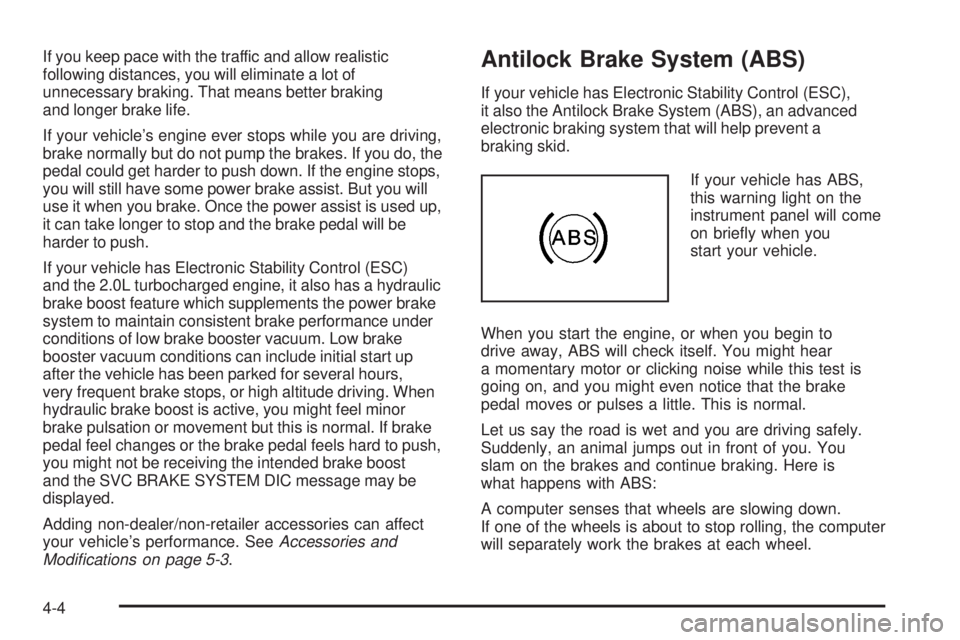
If you keep pace with the traffic and allow realistic
following distances, you will eliminate a lot of
unnecessary braking. That means better braking
and longer brake life.
If your vehicle’s engine ever stops while you are driving,
brake normally but do not pump the brakes. If you do, the
pedal could get harder to push down. If the engine stops,
you will still have some power brake assist. But you will
use it when you brake. Once the power assist is used up,
it can take longer to stop and the brake pedal will be
harder to push.
If your vehicle has Electronic Stability Control (ESC)
and the 2.0L turbocharged engine, it also has a hydraulic
brake boost feature which supplements the power brake
system to maintain consistent brake performance under
conditions of low brake booster vacuum. Low brake
booster vacuum conditions can include initial start up
after the vehicle has been parked for several hours,
very frequent brake stops, or high altitude driving. When
hydraulic brake boost is active, you might feel minor
brake pulsation or movement but this is normal. If brake
pedal feel changes or the brake pedal feels hard to push,
you might not be receiving the intended brake boost
and the SVC BRAKE SYSTEM DIC message may be
displayed.
Adding non-dealer/non-retailer accessories can affect
your vehicle’s performance. SeeAccessories and
Modifications on page 5-3.Antilock Brake System (ABS)
If your vehicle has Electronic Stability Control (ESC),
it also the Antilock Brake System (ABS), an advanced
electronic braking system that will help prevent a
braking skid.
If your vehicle has ABS,
this warning light on the
instrument panel will come
on brie�y when you
start your vehicle.
When you start the engine, or when you begin to
drive away, ABS will check itself. You might hear
a momentary motor or clicking noise while this test is
going on, and you might even notice that the brake
pedal moves or pulses a little. This is normal.
Let us say the road is wet and you are driving safely.
Suddenly, an animal jumps out in front of you. You
slam on the brakes and continue braking. Here is
what happens with ABS:
A computer senses that wheels are slowing down.
If one of the wheels is about to stop rolling, the computer
will separately work the brakes at each wheel.
4-4
Page 175 of 348
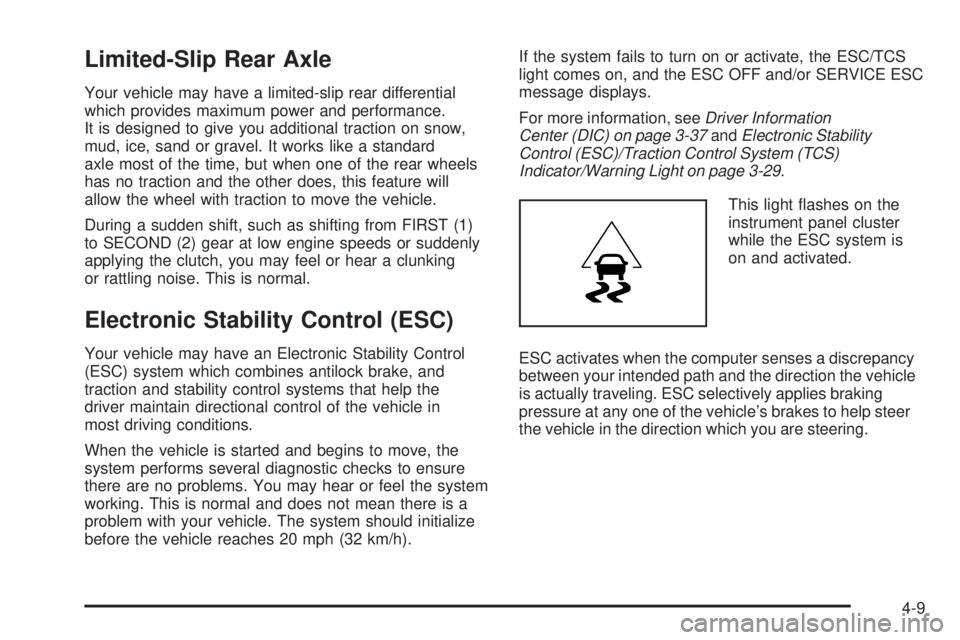
Limited-Slip Rear Axle
Your vehicle may have a limited-slip rear differential
which provides maximum power and performance.
It is designed to give you additional traction on snow,
mud, ice, sand or gravel. It works like a standard
axle most of the time, but when one of the rear wheels
has no traction and the other does, this feature will
allow the wheel with traction to move the vehicle.
During a sudden shift, such as shifting from FIRST (1)
to SECOND (2) gear at low engine speeds or suddenly
applying the clutch, you may feel or hear a clunking
or rattling noise. This is normal.
Electronic Stability Control (ESC)
Your vehicle may have an Electronic Stability Control
(ESC) system which combines antilock brake, and
traction and stability control systems that help the
driver maintain directional control of the vehicle in
most driving conditions.
When the vehicle is started and begins to move, the
system performs several diagnostic checks to ensure
there are no problems. You may hear or feel the system
working. This is normal and does not mean there is a
problem with your vehicle. The system should initialize
before the vehicle reaches 20 mph (32 km/h).If the system fails to turn on or activate, the ESC/TCS
light comes on, and the ESC OFF and/or SERVICE ESC
message displays.
For more information, seeDriver Information
Center (DIC) on page 3-37andElectronic Stability
Control (ESC)/Traction Control System (TCS)
Indicator/Warning Light on page 3-29.
This light �ashes on the
instrument panel cluster
while the ESC system is
on and activated.
ESC activates when the computer senses a discrepancy
between your intended path and the direction the vehicle
is actually traveling. ESC selectively applies braking
pressure at any one of the vehicle’s brakes to help steer
the vehicle in the direction which you are steering.
4-9
Page 188 of 348
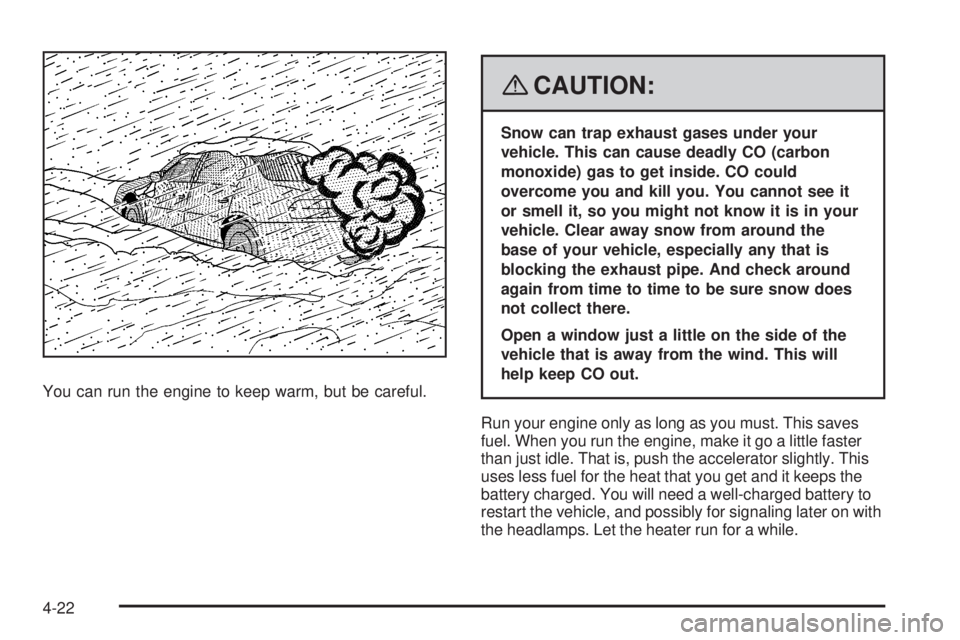
You can run the engine to keep warm, but be careful.
{CAUTION:
Snow can trap exhaust gases under your
vehicle. This can cause deadly CO (carbon
monoxide) gas to get inside. CO could
overcome you and kill you. You cannot see it
or smell it, so you might not know it is in your
vehicle. Clear away snow from around the
base of your vehicle, especially any that is
blocking the exhaust pipe. And check around
again from time to time to be sure snow does
not collect there.
Open a window just a little on the side of the
vehicle that is away from the wind. This will
help keep CO out.
Run your engine only as long as you must. This saves
fuel. When you run the engine, make it go a little faster
than just idle. That is, push the accelerator slightly. This
uses less fuel for the heat that you get and it keeps the
battery charged. You will need a well-charged battery to
restart the vehicle, and possibly for signaling later on with
the headlamps. Let the heater run for a while.
4-22
Page 201 of 348
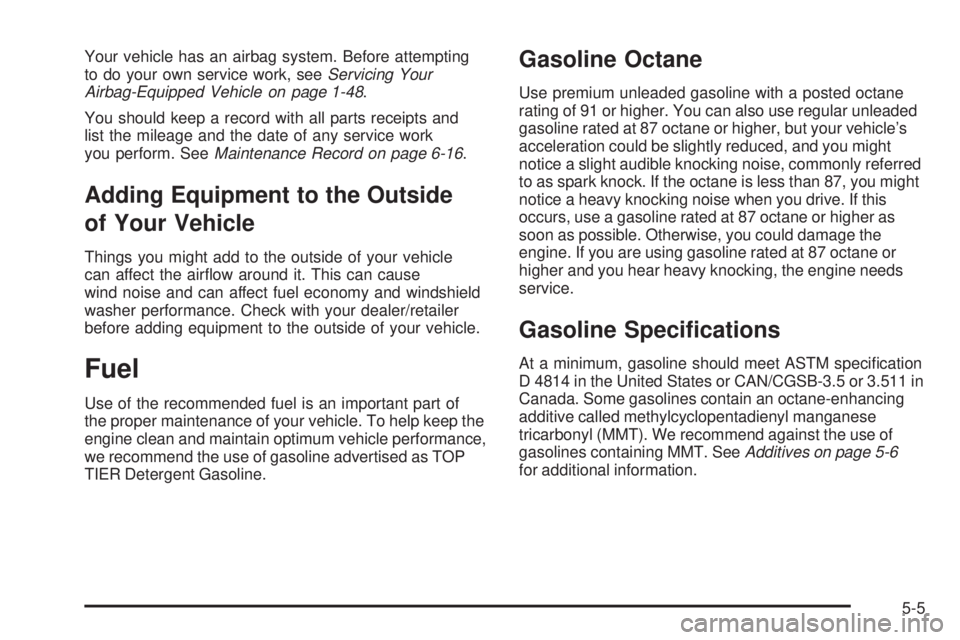
Your vehicle has an airbag system. Before attempting
to do your own service work, seeServicing Your
Airbag-Equipped Vehicle on page 1-48.
You should keep a record with all parts receipts and
list the mileage and the date of any service work
you perform. SeeMaintenance Record on page 6-16.
Adding Equipment to the Outside
of Your Vehicle
Things you might add to the outside of your vehicle
can affect the air�ow around it. This can cause
wind noise and can affect fuel economy and windshield
washer performance. Check with your dealer/retailer
before adding equipment to the outside of your vehicle.
Fuel
Use of the recommended fuel is an important part of
the proper maintenance of your vehicle. To help keep the
engine clean and maintain optimum vehicle performance,
we recommend the use of gasoline advertised as TOP
TIER Detergent Gasoline.
Gasoline Octane
Use premium unleaded gasoline with a posted octane
rating of 91 or higher. You can also use regular unleaded
gasoline rated at 87 octane or higher, but your vehicle’s
acceleration could be slightly reduced, and you might
notice a slight audible knocking noise, commonly referred
to as spark knock. If the octane is less than 87, you might
notice a heavy knocking noise when you drive. If this
occurs, use a gasoline rated at 87 octane or higher as
soon as possible. Otherwise, you could damage the
engine. If you are using gasoline rated at 87 octane or
higher and you hear heavy knocking, the engine needs
service.
Gasoline Speci�cations
At a minimum, gasoline should meet ASTM speci�cation
D 4814 in the United States or CAN/CGSB-3.5 or 3.511 in
Canada. Some gasolines contain an octane-enhancing
additive called methylcyclopentadienyl manganese
tricarbonyl (MMT). We recommend against the use of
gasolines containing MMT. SeeAdditives on page 5-6
for additional information.
5-5
Page 239 of 348
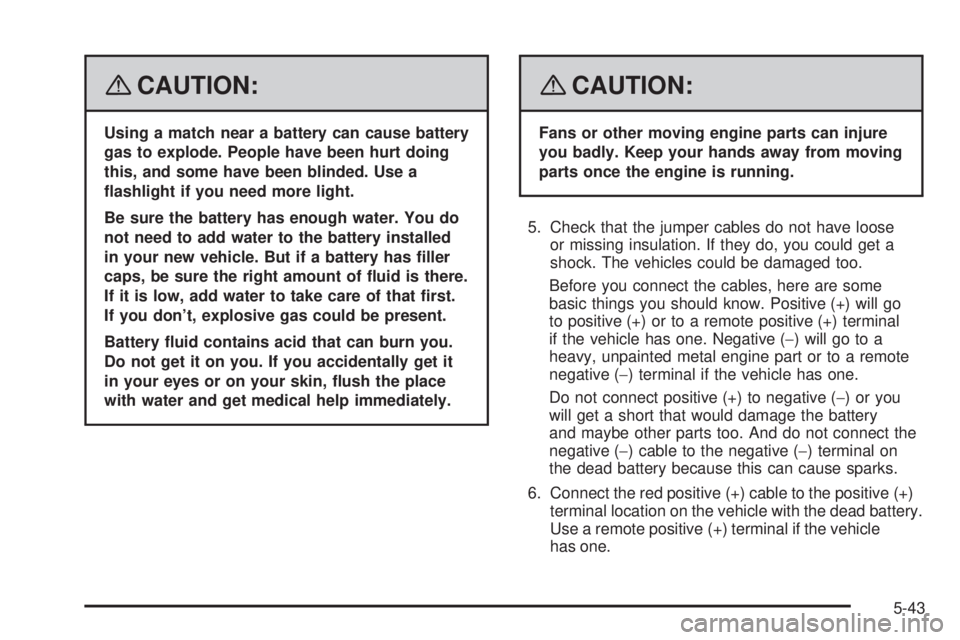
{CAUTION:
Using a match near a battery can cause battery
gas to explode. People have been hurt doing
this, and some have been blinded. Use a
�ashlight if you need more light.
Be sure the battery has enough water. You do
not need to add water to the battery installed
in your new vehicle. But if a battery has �ller
caps, be sure the right amount of �uid is there.
If it is low, add water to take care of that �rst.
If you don’t, explosive gas could be present.
Battery �uid contains acid that can burn you.
Do not get it on you. If you accidentally get it
in your eyes or on your skin, �ush the place
with water and get medical help immediately.
{CAUTION:
Fans or other moving engine parts can injure
you badly. Keep your hands away from moving
parts once the engine is running.
5. Check that the jumper cables do not have loose
or missing insulation. If they do, you could get a
shock. The vehicles could be damaged too.
Before you connect the cables, here are some
basic things you should know. Positive (+) will go
to positive (+) or to a remote positive (+) terminal
if the vehicle has one. Negative (−) will go to a
heavy, unpainted metal engine part or to a remote
negative (−) terminal if the vehicle has one.
Do not connect positive (+) to negative (−)oryou
will get a short that would damage the battery
and maybe other parts too. And do not connect the
negative (−) cable to the negative (−) terminal on
the dead battery because this can cause sparks.
6. Connect the red positive (+) cable to the positive (+)
terminal location on the vehicle with the dead battery.
Use a remote positive (+) terminal if the vehicle
has one.
5-43
Page 305 of 348
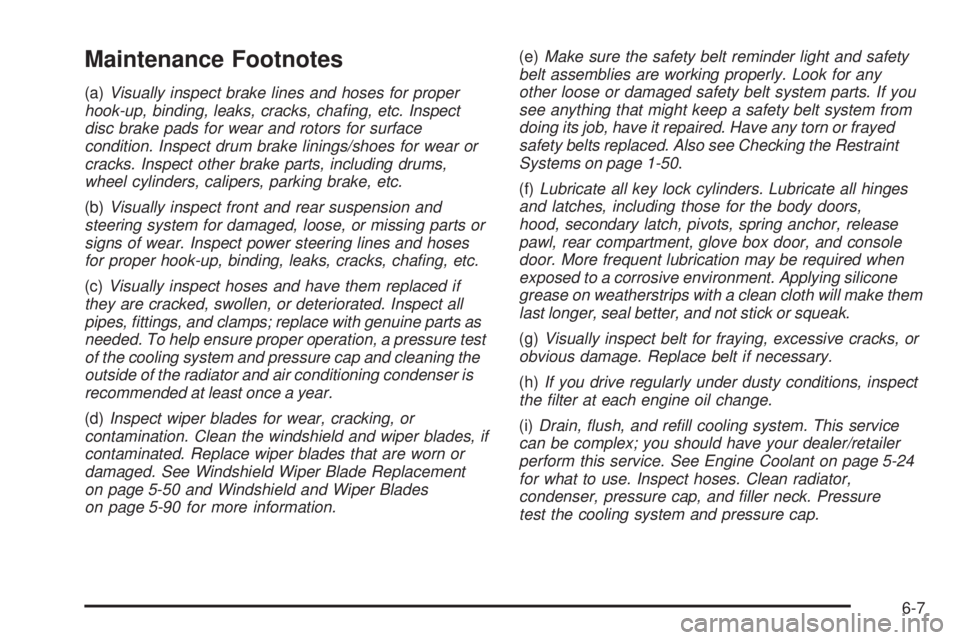
Maintenance Footnotes
(a)Visually inspect brake lines and hoses for proper
hook-up, binding, leaks, cracks, chafing, etc. Inspect
disc brake pads for wear and rotors for surface
condition. Inspect drum brake linings/shoes for wear or
cracks. Inspect other brake parts, including drums,
wheel cylinders, calipers, parking brake, etc.
(b)Visually inspect front and rear suspension and
steering system for damaged, loose, or missing parts or
signs of wear. Inspect power steering lines and hoses
for proper hook-up, binding, leaks, cracks, chafing, etc.
(c)Visually inspect hoses and have them replaced if
they are cracked, swollen, or deteriorated. Inspect all
pipes, fittings, and clamps; replace with genuine parts as
needed. To help ensure proper operation, a pressure test
of the cooling system and pressure cap and cleaning the
outside of the radiator and air conditioning condenser is
recommended at least once a year.
(d)Inspect wiper blades for wear, cracking, or
contamination. Clean the windshield and wiper blades, if
contaminated. Replace wiper blades that are worn or
damaged. See Windshield Wiper Blade Replacement
on page 5-50 and Windshield and Wiper Blades
on page 5-90 for more information.(e)Make sure the safety belt reminder light and safety
belt assemblies are working properly. Look for any
other loose or damaged safety belt system parts. If you
see anything that might keep a safety belt system from
doing its job, have it repaired. Have any torn or frayed
safety belts replaced. Also see Checking the Restraint
Systems on page 1-50.
(f)Lubricate all key lock cylinders. Lubricate all hinges
and latches, including those for the body doors,
hood, secondary latch, pivots, spring anchor, release
pawl, rear compartment, glove box door, and console
door. More frequent lubrication may be required when
exposed to a corrosive environment. Applying silicone
grease on weatherstrips with a clean cloth will make them
last longer, seal better, and not stick or squeak.
(g)Visually inspect belt for fraying, excessive cracks, or
obvious damage. Replace belt if necessary.
(h)If you drive regularly under dusty conditions, inspect
the filter at each engine oil change.
(i)Drain, flush, and refill cooling system. This service
can be complex; you should have your dealer/retailer
perform this service. See Engine Coolant on page 5-24
for what to use. Inspect hoses. Clean radiator,
condenser, pressure cap, and filler neck. Pressure
test the cooling system and pressure cap.
6-7
Page 338 of 348
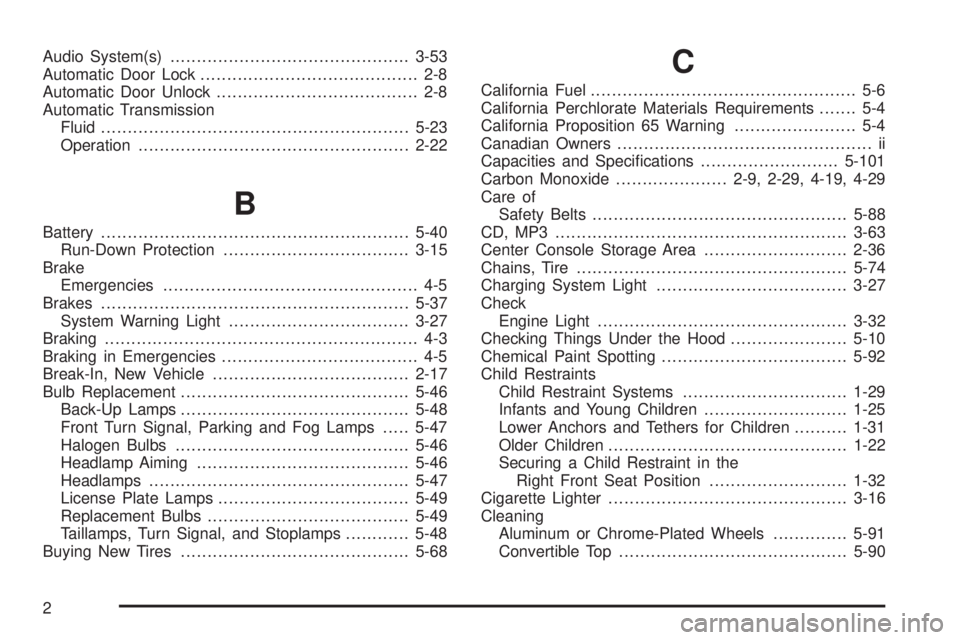
Audio System(s).............................................3-53
Automatic Door Lock......................................... 2-8
Automatic Door Unlock...................................... 2-8
Automatic Transmission
Fluid..........................................................5-23
Operation...................................................2-22
B
Battery..........................................................5-40
Run-Down Protection...................................3-15
Brake
Emergencies................................................ 4-5
Brakes..........................................................5-37
System Warning Light..................................3-27
Braking........................................................... 4-3
Braking in Emergencies..................................... 4-5
Break-In, New Vehicle.....................................2-17
Bulb Replacement...........................................5-46
Back-Up Lamps...........................................5-48
Front Turn Signal, Parking and Fog Lamps.....5-47
Halogen Bulbs............................................5-46
Headlamp Aiming........................................5-46
Headlamps.................................................5-47
License Plate Lamps....................................5-49
Replacement Bulbs......................................5-49
Taillamps, Turn Signal, and Stoplamps............5-48
Buying New Tires...........................................5-68
C
California Fuel.................................................. 5-6
California Perchlorate Materials Requirements....... 5-4
California Proposition 65 Warning....................... 5-4
Canadian Owners................................................ ii
Capacities and Speci�cations..........................5-101
Carbon Monoxide.....................2-9, 2-29, 4-19, 4-29
Care of
Safety Belts................................................5-88
CD, MP3 .......................................................3-63
Center Console Storage Area...........................2-36
Chains, Tire...................................................5-74
Charging System Light....................................3-27
Check
Engine Light...............................................3-32
Checking Things Under the Hood......................5-10
Chemical Paint Spotting...................................5-92
Child Restraints
Child Restraint Systems...............................1-29
Infants and Young Children...........................1-25
Lower Anchors and Tethers for Children..........1-31
Older Children.............................................1-22
Securing a Child Restraint in the
Right Front Seat Position..........................1-32
Cigarette Lighter.............................................3-16
Cleaning
Aluminum or Chrome-Plated Wheels..............5-91
Convertible Top...........................................5-90
2
Page 340 of 348
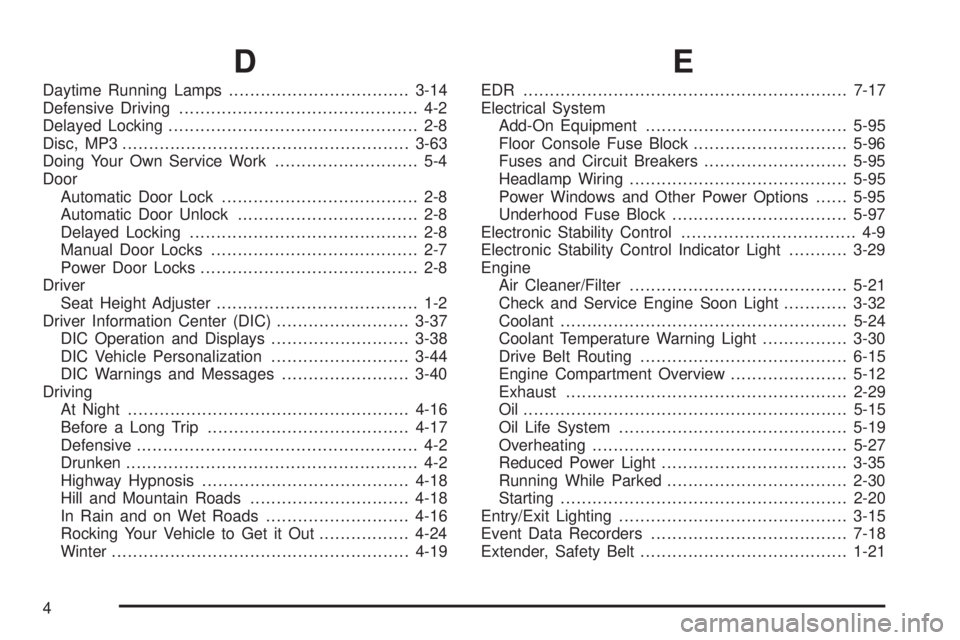
D
Daytime Running Lamps..................................3-14
Defensive Driving............................................. 4-2
Delayed Locking............................................... 2-8
Disc, MP3......................................................3-63
Doing Your Own Service Work........................... 5-4
Door
Automatic Door Lock..................................... 2-8
Automatic Door Unlock.................................. 2-8
Delayed Locking........................................... 2-8
Manual Door Locks....................................... 2-7
Power Door Locks......................................... 2-8
Driver
Seat Height Adjuster...................................... 1-2
Driver Information Center (DIC).........................3-37
DIC Operation and Displays..........................3-38
DIC Vehicle Personalization..........................3-44
DIC Warnings and Messages........................3-40
Driving
At Night.....................................................4-16
Before a Long Trip......................................4-17
Defensive..................................................... 4-2
Drunken....................................................... 4-2
Highway Hypnosis.......................................4-18
Hill and Mountain Roads..............................4-18
In Rain and on Wet Roads...........................4-16
Rocking Your Vehicle to Get it Out.................4-24
Winter........................................................4-19
E
EDR .............................................................7-17
Electrical System
Add-On Equipment......................................5-95
Floor Console Fuse Block.............................5-96
Fuses and Circuit Breakers...........................5-95
Headlamp Wiring.........................................5-95
Power Windows and Other Power Options......5-95
Underhood Fuse Block.................................5-97
Electronic Stability Control................................. 4-9
Electronic Stability Control Indicator Light...........3-29
Engine
Air Cleaner/Filter.........................................5-21
Check and Service Engine Soon Light............3-32
Coolant......................................................5-24
Coolant Temperature Warning Light................3-30
Drive Belt Routing.......................................6-15
Engine Compartment Overview......................5-12
Exhaust.....................................................2-29
Oil .............................................................5-15
Oil Life System...........................................5-19
Overheating................................................5-27
Reduced Power Light...................................3-35
Running While Parked..................................2-30
Starting......................................................2-20
Entry/Exit Lighting...........................................3-15
Event Data Recorders.....................................7-18
Extender, Safety Belt.......................................1-21
4
Page 342 of 348
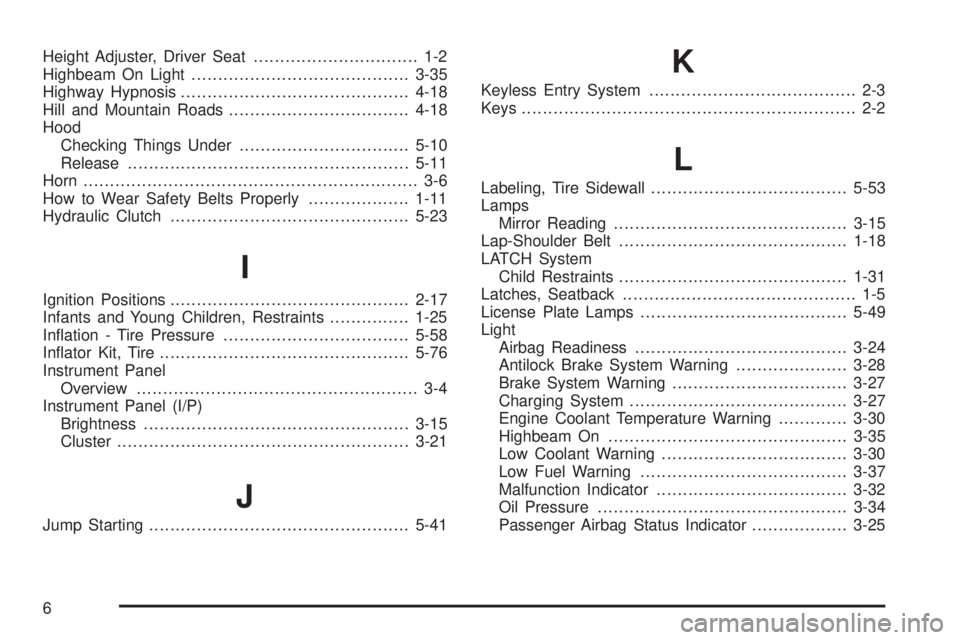
Height Adjuster, Driver Seat............................... 1-2
Highbeam On Light.........................................3-35
Highway Hypnosis...........................................4-18
Hill and Mountain Roads..................................4-18
Hood
Checking Things Under................................5-10
Release.....................................................5-11
Horn............................................................... 3-6
How to Wear Safety Belts Properly...................1-11
Hydraulic Clutch.............................................5-23
I
Ignition Positions.............................................2-17
Infants and Young Children, Restraints...............1-25
In�ation - Tire Pressure...................................5-58
In�ator Kit, Tire...............................................5-76
Instrument Panel
Overview..................................................... 3-4
Instrument Panel (I/P)
Brightness..................................................3-15
Cluster.......................................................3-21
J
Jump Starting.................................................5-41
K
Keyless Entry System....................................... 2-3
Keys............................................................... 2-2
L
Labeling, Tire Sidewall.....................................5-53
Lamps
Mirror Reading............................................3-15
Lap-Shoulder Belt...........................................1-18
LATCH System
Child Restraints...........................................1-31
Latches, Seatback............................................ 1-5
License Plate Lamps.......................................5-49
Light
Airbag Readiness........................................3-24
Antilock Brake System Warning.....................3-28
Brake System Warning.................................3-27
Charging System.........................................3-27
Engine Coolant Temperature Warning.............3-30
Highbeam On.............................................3-35
Low Coolant Warning...................................3-30
Low Fuel Warning.......................................3-37
Malfunction Indicator....................................3-32
Oil Pressure...............................................3-34
Passenger Airbag Status Indicator..................3-25
6
Page 343 of 348
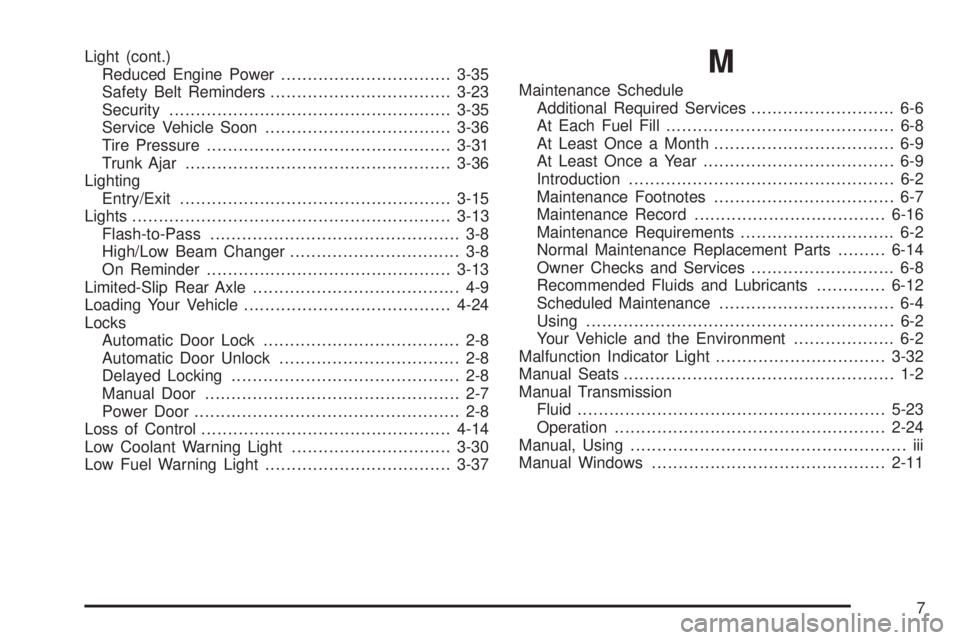
Light (cont.)
Reduced Engine Power................................3-35
Safety Belt Reminders..................................3-23
Security.....................................................3-35
Service Vehicle Soon...................................3-36
Tire Pressure..............................................3-31
Trunk Ajar..................................................3-36
Lighting
Entry/Exit...................................................3-15
Lights............................................................3-13
Flash-to-Pass............................................... 3-8
High/Low Beam Changer................................ 3-8
On Reminder..............................................3-13
Limited-Slip Rear Axle....................................... 4-9
Loading Your Vehicle.......................................4-24
Locks
Automatic Door Lock..................................... 2-8
Automatic Door Unlock.................................. 2-8
Delayed Locking........................................... 2-8
Manual Door................................................ 2-7
Power Door.................................................. 2-8
Loss of Control...............................................4-14
Low Coolant Warning Light..............................3-30
Low Fuel Warning Light...................................3-37M
Maintenance Schedule
Additional Required Services........................... 6-6
At Each Fuel Fill........................................... 6-8
At Least Once a Month.................................. 6-9
At Least Once a Year.................................... 6-9
Introduction.................................................. 6-2
Maintenance Footnotes.................................. 6-7
Maintenance Record....................................6-16
Maintenance Requirements............................. 6-2
Normal Maintenance Replacement Parts.........6-14
Owner Checks and Services........................... 6-8
Recommended Fluids and Lubricants.............6-12
Scheduled Maintenance................................. 6-4
Using.......................................................... 6-2
Your Vehicle and the Environment................... 6-2
Malfunction Indicator Light................................3-32
Manual Seats................................................... 1-2
Manual Transmission
Fluid..........................................................5-23
Operation...................................................2-24
Manual, Using.................................................... iii
Manual Windows............................................2-11
7